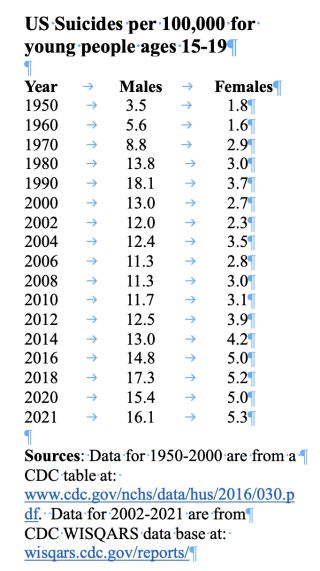Adolescence
Dramatic Changes in Teen Suicide Rates Over Seven Decades
Honest question: What might explain the rise, fall, and rise in teen suicides?
Posted September 3, 2023 Reviewed by Hara Estroff Marano
There has been much press recently about the rise in suicides among teens over the past few years. In order, quite literally, to get a picture of these data, and to see how recent years compare with past decades, and to see how the rates differ between young males and young females, I compiled data from records kept by the Centers for Disease Control and Prevention (CDC) to create the following graph, along with a table of the data shown in the graph. [You can see I'm old-school here. I found it easier to draw the graph on graph paper than to figure out how to do it on Excel and get the points in the right places.]


A number of things stand out in the graph.
First, regardless of year, the suicide rate is much higher for males than for females. It is often reported that females attempt suicide more often than males, but their methods are less deadly and are reversed by treatment. When a suicide attempt does not lead to death, however, it is hard to know if it was an actual attempt or a dramatic way of calling for help.
The second thing to notice is the huge, almost linear increase in suicide rate for teen males between 1950 and 1990. The rate per 100,000 individuals increased more than five-fold, from 3.5 to 18.1. In contrast, the increase in rate for females over these same years was just a shade over two-fold, from 1.8 to 3.7.
The third dramatic thing to notice is the sharp drop in male suicides between 1990 and 2002 and a more modest decline in rate for females over that 12-year span.
The fourth dramatic thing to notice is that the male rate rose steeply again from 2010 to 2018. In fact, over this period it rose at about the same high rate as it had risen between 1970 and 1990, though it did not quite reach the 1990 peak. The rate for females also increased from 2010 to 2018, at a rate of increase higher than in any period before that time, but the slope of increase was still much less than that for males. [Parenthetically, I note that the dip in suicide rate in 2020 was most likely the result of the decline in suicides during the months when schools were closed for COVID—for more on that, see here.]
So, I have the following questions:
1. What was happening between 1950 and 1990 that caused a dramatic and essentially linear increase in suicides for teen boys over this period and a much smaller increase for teen girls?
2. What was happening between 1990 and 2002 that caused a dramatic decline in suicides for teen boys and a much smaller decline for teen girls?
3. What was happening between 2010 and 2018 that caused a dramatic increase in suicides for teen boys and a smaller but still substantial increase for teen girls?
These are real questions. I don’t know the answers, though I have some ideas. I’m asking in order to solicit readers’ hypotheses concerning each question. What are your thoughts on this? Psychology Today does not allow comments on posts, so I have also posted this on a different platform, where you can comment. I invite you to comment here.


